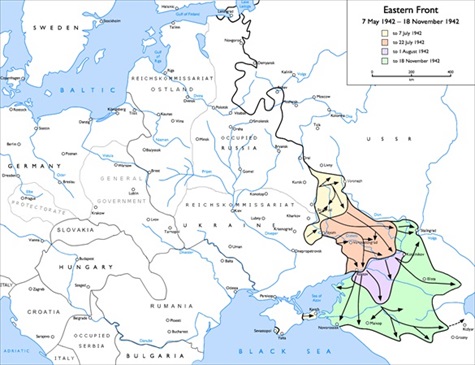BLUE, OPERATION (FALL BLAU) (JUNE–NOVEMBER 1942)
| When | June 28 to November 24, 1942 |
| Where | Soviet Caucasus region lying between the Black and the Caspian seas
|
| Who | In preparation for Operation (Case) Blue (German, Fall Blau), Army Group South of the German Army was subdivided into Army Groups A and B. Army Group A was initially commanded by Field Marshall Wilhelm von List (1880–1971), but from September 9 to November 1942 Hitler took personal command. Army Group B under Maximilian von Weichs (1881–1954) was given the task of protecting the northern flank of Army Group A, and included Gen. Friedrich Paulus’ Sixth Army. In addition to the German armies, Army Group B included the Second Hungarian Army, the Eighth Italian Army, and the Third and the Fourth Romanian Armies. Arrayed against the Axis armies were four Soviet army groups: the Voronezh Front (formerly the Bryansk front), the Southwestern Front, the Southern Front, and the North Caucasian Front. |
| What | Operation Blue was the Wehrmacht’s name for its 1942 strategic summer offensive in southern Russia between June 28 and November 24, 1942. Championed by Hitler, Operation Blue involved a two-pronged attack against the rich oilfields of Baku in today’s Azerbaijan (which provided the Soviet Union with 80 percent of its oil needs), as well as an advance in the direction of Stalingrad, an industrial city and transportation nexus along the Volga River, to cover the flanks of the advance towards Baku. The Germans and their allies had 1.3 million men, 1,900 tanks, and 1,610 aircraft. Facing the Axis armies were 1.7 million Soviets, with another one million in reserve, 3,720 tanks, and roughly 1,670 aircraft. |
| Army Group A quickly swept south to the foothills of the Caucasus Mountains, but as the Soviets fell back they sabotaged the oil fields. Stiff Soviet resistance in the mountains, fresh Soviet reinforcements, and logistical problems slowed Army Group A’s momentum, and Hitler relieved von List of his command. By this time the Sixth Army under Paulus was approaching the suburbs of Stalingrad. But another Russian winter was also approaching, and German supply lines were very long. | |
| Why | Operation Blue was a continuation of Operation Barbarossa, which the previous year had ground to a frigid, snowy halt before Moscow, the Soviet Union’s capital. In Fuehrer Directive No. 41, issued April 5, 1942, Hitler ordered the German High Command to “wipe out the entire defense potential remaining to the Soviets and cut them off, as far as possible, from their most important centers of war industry” before the presence of the United States, which had entered the war on the side of Great Britain on December 11, 1941, could have any effect on the war. |
| Outcome | Due to the significant initial successes of the 1942 German summer offensive, the German command and especially Hitler did not expect the Soviets to be able to launch a counteroffensive on any significant scale. But the German army and its allies, overstretched by the vast area they had captured, were hard-pressed to mount a decisive offensive at Stalingrad after the Sixth Army had gotten into trouble. Soon both sides concentrated largely on the epic struggle for the city named after the Soviet leader, rendering the Caucasus campaign a sideshow. With Army Group B unable to hold its line on the Volga river, subsequent Soviet operations threatened to cut off Army Group A in the Caucasus, and it was forced to withdraw, thereby ending Hitler’s dream of capturing and exploiting the region’s valuable oilfields. (Hitler’s dream of exploiting the oilfields once they were captured took no account of how to get the oil from the Caucasus to Germany where it was needed.) The surrender of Paulus’ Sixth Army in Stalingrad was another serious blow to German morale in general and it proved a personal shock to Hitler. Nevertheless, despite the destruction of the Sixth Army, the Soviets only caused the Germans to let loose their summer gains, further delaying the final outcome on the Eastern Front. |
![]()
1942 German Summer Offensive in East: Fall Blau (Case Blue), Examining the Disaster
![]()


 History buffs, there is good news! The Daily Chronicles of World War II is now available as an ebook for $4.99 on Amazon.com. Containing a year’s worth of dated entries from this website, the ebook brings the story of this tumultuous era to life in a compelling, authoritative, and succinct manner. Featuring inventive navigation aids, the ebook enables readers to instantly move forward or backward by month and date to different dated entries. Simple and elegant! Click
History buffs, there is good news! The Daily Chronicles of World War II is now available as an ebook for $4.99 on Amazon.com. Containing a year’s worth of dated entries from this website, the ebook brings the story of this tumultuous era to life in a compelling, authoritative, and succinct manner. Featuring inventive navigation aids, the ebook enables readers to instantly move forward or backward by month and date to different dated entries. Simple and elegant! Click 











